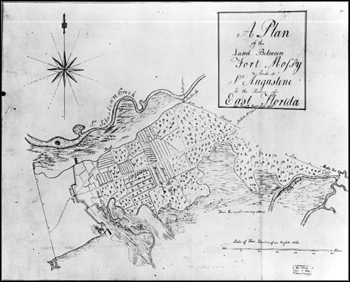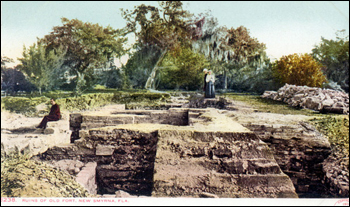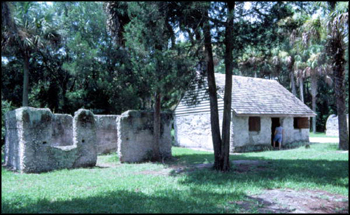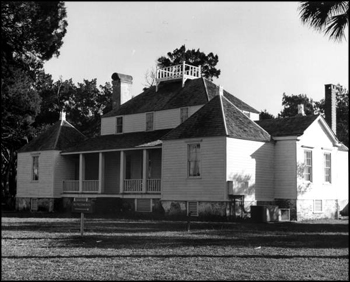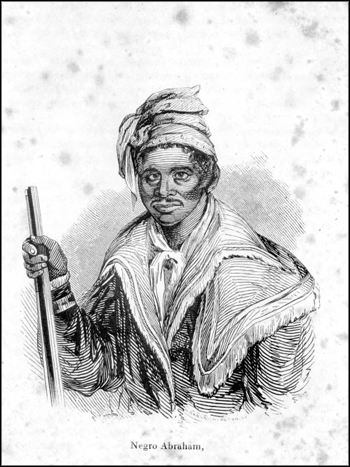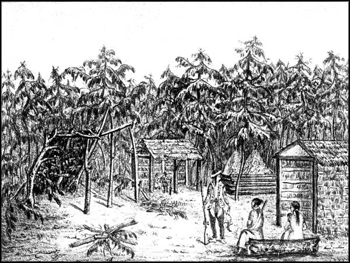Photo Exhibits
Photo exhibits spotlight various topics in Florida history, and are accompanied by brief text intended to place selected materials in historical context.
Plantation Culture
Land and Labor in Florida History
The British Interlude and the Second Spanish Period, 1763-1821
In 1763, Great Britain gained control of Florida following the Seven Years War. British planters initiated large-scale agricultural enterprises in east Florida based on African slave labor. During the British period, the majority of slaves in Florida came directly from Africa. Most planters resided south of St. Augustine on the St. Johns and Indian Rivers. The harsh, swampy conditions of east Florida earned the region the name "Mosquito Coast" during the British period.
Plan of the land between Fort Mossey (Mose) and St. Augustine (ca. 1770s)
Image Number: RC12824
This map shows British agricultural activities near the city of St. Augustine.
Labor on British Plantations in Florida
During 20 years of British occupation, Florida plantations exported significant quantities of indigo, citrus, sugar and naval stores. Slavery existed under Spanish rule; however, African slavery became more prominent after the British took control of Florida. For example, in the 1760s and 1770s over 100 slaves toiled on Richard Oswald's sugar and indigo plantation on the Tomoka River in present day Volusia County.
The practice of arming free blacks at Fort Mose underscored the differing views of Spanish and British colonists about African slavery. African slaves constituted the majority in British-controlled Florida, numbering about 11,200 of a total population of 17,300, or nearly 65 percent. At the end of the first Spanish period in 1763, the enslaved made up roughly 13% of the colony's population. Of the 420 persons of African descent living in Spanish Florida in 1763, one-fifth were free blacks serving the Spanish crown.
In 1768, Scottish physician turned planter, Andrew Turnbull, attempted to found a colony of free workers near what is now New Smyrna. Turnbull recruited over 1,200 laborers from the Mediterranean island of Minorca to develop indigo plantations. Poor working conditions and disputes between the Minorcan laborers and their British overseers caused the colony to collapse by 1777. The remaining colonists fled north to St. Augustine where many of their descendants remain today.
Postcard showing the ruins of Andrew Turnbull's warehouse: New Smyrna, Florida (1904)
Image Number: PC2408<
British Planters and African Slaves
Unlike Turnbull's New Smyrna experiment, most British planters relied on African slave labor. The presence of a large number of African slaves along the Florida frontier resulted in tensions between Native Americans and slave-owning Europeans.
Many slaves sought freedom among the Seminoles during the 18th and 19th centuries, much to the dismay of planters in Georgia, Florida and the Carolinas. Planters retaliated by raiding Native American and free black settlements.
Tabby slave cabins at the Kingsley Plantation State Historic Site: Fort George Island, Florida (1982)
Image Number: PR14332
Slaves built these cabins on the northeast Florida plantation of Zephaniah Kingsley. The State of Florida restored several cabins on the site, now administered by the National Park Service. Between 1814 and 1837, Kingsley operated a plantation on Fort George Island specializing in Sea Island cotton.
Main house at the Kingsley Plantation State Historic Site: Fort George Island, Florida (mid 20th century)
Image Number: RC20275
The State of Florida operated the Kingsley Plantation Historic Site from the 1950s until 1989. In 1989, the Kingsley Plantation became part of the Timucuan Ecological and Historical Preserve administered by the National Park Service.
End of the British Period and the Return to Spanish Rule
The American victory in the Revolutionary War ended Great Britain's occupation of Florida. In 1783, Florida again became a Spanish territory. The Spanish did little to expand agricultural production between 1783 and 1821, focusing instead on cultivating trading relationships with the nearby Creeks and Seminoles.
Because of the limited extent of Spanish settlement, Native American tribes and free blacks effectively controlled the majority of the interior Florida peninsula until the arrival of American military forces during the First Seminole War (1816-1819).
Abraham, former slave and interpreter for Micanopy during the Seminole Wars (ca. 1840)
Image Number: RC08709
Abraham fled slavery and joined the Seminoles. He became a trusted interpreter for the Seminole leader Micanopy.
Creek Indian village on the Apalachicola River (1838 or 1839)
Image Number: RC12212
The Frenchman Francis comte de Castelnau sketched this Creek Indian village while visiting north Florida in the late 1830s.

 Listen: The Folk Program
Listen: The Folk Program